Marulanda J.M. (ed.) Electronic Properties of Carbon Nanotubes
Подождите немного. Документ загружается.

30
Strategies to Successfully
Cross-Link Carbon Nanotubes
Steve F. A. Acquah, Darryl N. Ventura and Harold W. Kroto
Florida State University
United States
1. Introduction
Since the inception of the research field on carbon nanotubes (CNTs), there has been an
enormous effort to understand how the tubes form and how to best garner their unique
electronic and mechanical properties. It soon became apparent that in order to develop the
next generation of functional materials, a way to modify the surface of the tubes and connect
them was required. The development of the oxidation process with acids was the first
revolution in the field of CNTs, potentially opening the door to an extensive library of
modifications. Research progressed by integrating the nanotubes into composites at low
concentrations with some success, but the goal of producing high nanotube component
covalently cross-linked materials was still problematic. Two decades after the report by
Sumio Ijima on their discovery, cross-linked CNT materials are still difficult to produce, and
this has shifted the field towards a back-to-basics approach to try and solve the problem.
One key problem identified was the presence of lattice fragments immobilized on the
surface of the CNTs (Fig. 1.). The current methods of characterization such as X-ray
photoelectron, Infrared and Raman spectroscopy are indirect and generally fail to
distinguish between the surface attached functional groups and oxidized lattice fragments.
A CNT washing technique has been developed to remove these fragments and any
electrostatically attached products to allow pure covalent interactions with the surface of the
nanotube (Wang et al., 2010). With an industry now thriving on the production of cheap
functionalized carbon vapor deposition (CVD) CNTs, priced according to the percentage
surface functionalization, and the decline in published materials on arc-produced CNTs, the
need for effective characterization and quality control increases.
It is the intention of this chapter to review some of the successful approaches used to cross-
link CNTs with a focus on the importance of the chemistry and techniques involved, and
highlight two areas of research we are currently investigating at Florida State University.
1.1 The characterization dilemma
As the basic unit for nanotubes, single-walled carbon nanotubes (SWCNT) have been
envisaged as a solution in areas such as molecular wires to biological transport vectors,
however in order to reach this potential, we need to be able to modify the surface structure.
The solubility of SWCNTs is on average 0.1 mg/ml, however this can be increased to 1
mg/ml with surface modification. The problem with this form of modification is that the
inherent properties of the nanotubes, both the mechanical and electronic properties, can be
significantly altered, questioning the reasons for modifying the tubes.
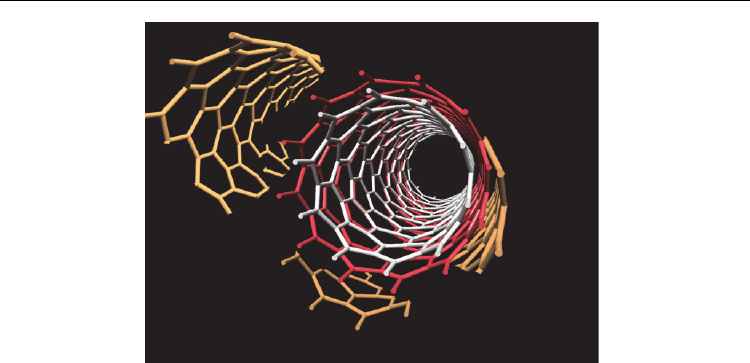
Electronic Properties of Carbon Nanotubes
666
Fig. 1. A carbon nanotube with lattice fragments on the surface. These fragments can be
easily oxidized and result in an incorrect assessment of the degree of CNT surface
functionalization.
One aspect of CNT research that can prove discouraging at times is the difficulty in the
direct characterization of functional moieties after a chemical process. Sidewall
functionalization is important for the use of the tubes in cross-linked composites. One of the
most popular techniques used in journals was Fourier Transform Infrared Spectroscopy
(FTIR). Whilst it is a powerful technique in organic chemistry, for CNTs it is difficult to
prove the presence of covalently attached groups although there are good indications of
hydroxyls, carbonyls and amine derivatives. The low concentration of functional groups on
the surface is also a problem for acquiring a sufficient signal and the generation of a good
baseline requires careful preparation. Raman spectroscopy is extremely popular due to the
characteristic D-band that measures the degree of disorder and the G-band that provides a
measure of the sp
2
character. While the ratio of the bands can provide an insight into the
quality of the tubes, it can be difficult to form a correlation between the distribution of the
functional groups and the ratio of the bands. UV spectroscopy (UV) requires the nanotubes
to be dispersed at a low concentration which is difficult, as the CNTs tend to sediment
during acquisition. Visual techniques such as transmission electron microscopy (TEM) and
scanning electron microscopy (SEM) can be useful for identifying regions and trends, but
the sample area is small for TEM and there are charging issues with SEM. Table 1 gives an
overview of the types of issues encountered with characterization.
2. Cross-linking methods
In this section, we will discuss some of the successful methods employed to facilitate the
cross-linking of CNTs. There are a variety of methods available and theoretical studies have
shown the possibility of the assembly of higher ordered structures, however the examples
listed here differ in the approach to cross-linking from aspects of defunctionalization to
nanocrystal interactions.

Strategies to Successfully Cross-Link Carbon Nanotubes
667
Methods Type Information Limitations of Technique
TGA Solid Functionalization ratio
No information on covalent
modification.
XPS Solid
Elements present and the
functionalization ratio
Inference of covalent
attachment but quantification is
restricted
Raman Solid
Degree of disorder and
sp
2
character
No direct chemical information
and interpretation is
problematic
Infra red (IR) Solid & Liquid
Groups
Analytical quantification not
advisable
UV/visible Liquid Sidewall functionalization
Solubility of sample is difficult
AFM Solid Topography
Sample size is small.
No information on the covalent
functionalization and no
chemical identity
TEM Solid
Transmission Image,
Lattice
Sample size is small.
Inference of covalent
functionalization only.
SEM Solid Secondary electrons No chemical identity
Table 1. A list of the limitations of the characterization techniques typically applied to CNTs.
Table adapted from a module by Liling Zeng and Andrew R. Barron.
2.1 Cyclo-addition reactions
The side-wall functionalization of CNTs is of great importance, primarily for increasing the
solubility of tubes, but equally important is the ability to process the CNTs to form
composites. One successful method is that of nitrene chemistry. Nitrenes (R-N:) are
structurally similar to carbenes (RR’C:) and are electron-deficient uncharged molecules,
which depending on the side groups, can facilitate addition and rearrangement reactions.
The singlet nitrenes can react with the sidewall of CNT’s by electrophilic [2+1] cyclo-
additions or by inter-system crossing. The triplet state reacts with the π system of the CNT
with both the singlet and triplet states resulting in the formation of aziridine rings (Fig. 2A).

Electronic Properties of Carbon Nanotubes
668
Cross-linking was achieved by using a di-azidocarbonate, based on poly-ethylene glycol
(PEG) (Holzinger et al., 2004). The preparation of the cross-linked nanotubes is a simple
process using SWCNTs dispersed in 1,1,2,2-tetrachloromethane (TCE) by sonication. The
suspension is then heated to 160 C and a 20-fold excess of diluted di-azidocarbonate in TCE
is added over a period of 30 mins. After cooling, the mixture is filtered and washed with
TCE and ethanol. This process is highly effective in cross-linking, but because of the length
and flexibility of the cross-linker it is possible for the linker to attach to the same tube
forming a loop (Fig. 2B).
The characterization of the composite was performed by using a range of techniques
including transmission electron microscopy, atomic force microscopy, Raman spectroscopy
and X-ray photoelectron spectroscopy. This cyclo-addition technique holds huge promise
for the development of further films using long chain nitrene based cross-linkers.
2.2 Ion beam and irradiation techniques
One other method of cross-linking carbon nanotubes is through electron or ion beam
irradiation. It has been theorized that cross-linking nanotubes could improve the overall
characteristics of nanotubes on the bulk scale. While this method can be achieved on both
SWCNTs and MWCNTs, this technique of cross-linking has both its advantages and
disadvantages. One advantage is that the setup is simple and there are no chemical reactions
that need to be performed. Another advantage is that the bonds formed between the tubes
are much stronger than the van der Waals interactions that are sometimes used to link
nanotubes. In addition to this, not only can individual tubes be cross-bonded, but it has been
demonstrated that it should be possible to link macroscopic carbon structures such as CNT
mats and fibers. According to simulations, ion irradiation will affect SWCNTs and
MWCNTs differently. The incident energy from irradiation will scatter carbon fragments
from a SWCNT, and a percentage of these fragments will be redistributed along the
nanotube surface. In the end, these fragments will form the cross-links between the
nanotubes. It was predicted that a much higher percentage (~50%) of the fragments will be
redistributed between the inner walls of MWCNTs. Therefore, cross-linking via irradiation
is more suitable for SWCNTs but it can still be used to reinforce the inner walls of a
MWCNTs. These theoretical predictions for cross-linking nanotubes have been confirmed
experimentally by researchers. An improvement in electron transport properties in bundles
of SWCNTs due to increased intertube coupling, after exposure to an Ar
+
beam, has also
been demonstrated (Stahl et al., 2000). It has been shown that electron irradiation of
MWCNTs can reinforce the inner walls (Fig. 3.) and stiffen the tubes by up to five
times (Duchamp et al., 2010). Studies have also looked into the possible mechanisms
involved in the radiation induced modification of CNTs (Kis et al., 2004). Similar results
have been reported (Peng et al., 2008) and have demonstrated improvements in fracture
strength.
Despite all these advantages and promising results for irradiation cross-linking, there are a
few drawbacks. One disadvantage is that it destroys the sp
2
bonding of the nanotube which
could be detrimental to the tubes’ intrinsic properties. Another disadvantage of this
technique is that the cross-linking capabilities are dependent on where the nanotube can be
exposed to the electron or ion beam. If you wanted to produce a cross-linked nanotube mat
(similar to buckypaper) only the surface layers of the CNT mat would be cross-linked as the
interior tubes would not be exposed to the incident beam.
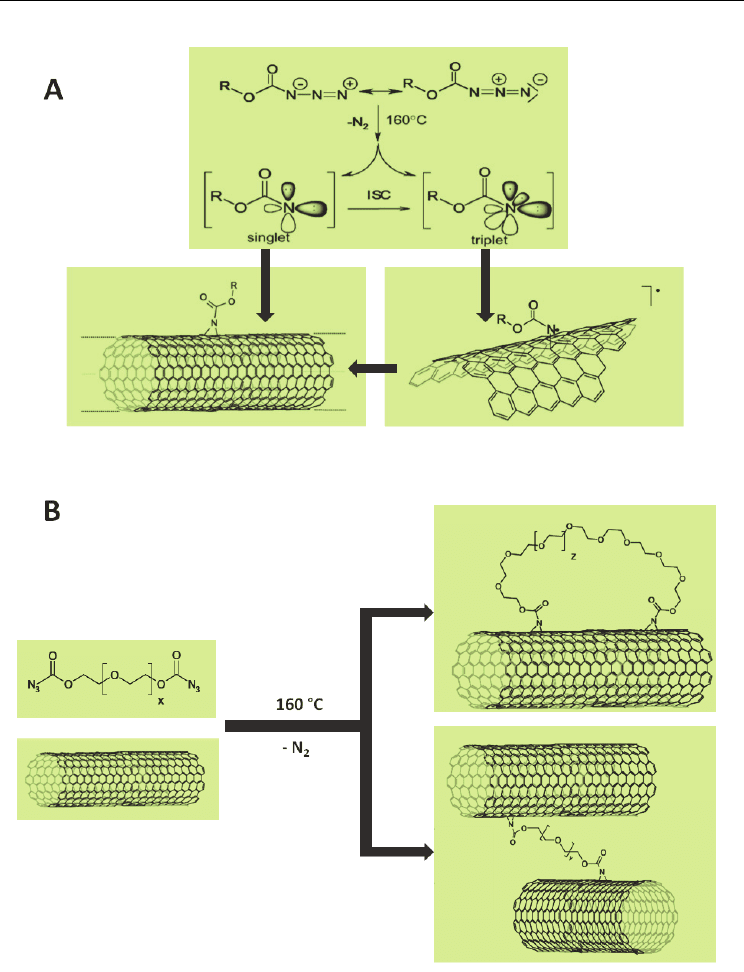
Strategies to Successfully Cross-Link Carbon Nanotubes
669
Fig. 2. A) Schematic presentation of the reaction of nitrenes with the nanotube sidewall. B)
Reaction of di-nitrenes with the nanotubes using diazidocarbonate polyglycolesters as
precursors. The addition of the di-functional molecule can also happen on the sidewall of
the same CNT resulting in the formation of a loop. Adapted from (Holzinger et al., 2004)
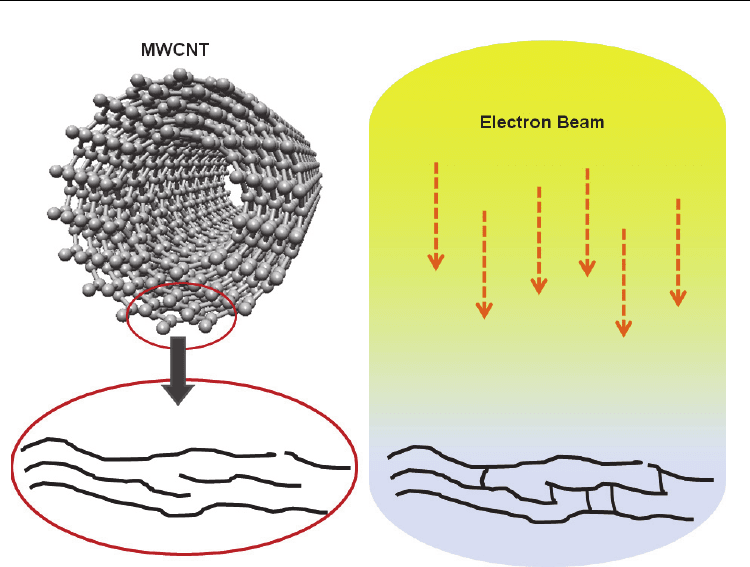
Electronic Properties of Carbon Nanotubes
670
Fig. 3. The reinforcement of the sidewalls of a MWCNT by an electron beam. This form of
cross-linking may be extended to neighboring tubes forming a covalently linked intertube
junction.
2.3 Michael addition
At Florida State University we have been exploring the nature of cross-linking between
CNTs. Inspired by the interaction of maleimides with cysteine for biological labeling and the
potential for the covalent interaction of CNTs, we used benzoquinone to cross-link thiolated
carbon nanotubes (MWCNT-SH) to form mats similar to buckypaper. We wanted to
develop a way of producing a cross-linked mat without the need to use high pressure
processes or electron beams to fuse the tubes together, so we applied a back-to-basics
approach and tried to identify the problems associated with poor cross-linking between the
tubes. It became apparent that the inability to control reaction conditions during the
formation of the mats was a problem so we attempted to maintain the temperature and
dispersion of the tubes until the mat was ready to be cast. The procedure involved
sonicating MWCNT-SH (1g, Nanocyl) with an excess of dithiothreitol (DTT) to separate the
nanotubes and break up the disulfide bonds. The MWCNT-SH were then washed with DMF
and dried for 12 h. From this batch, MWCNT-SH (20 mg) were dispersed in DMF (15 ml)
and sonicated. In a separate vial, benzoquinone (100 mg) was dissolved in DMF (10 ml). The
benzoquinone solution was slowly added to the nanotube suspension and the mixture was
stirred at 75 C for 12 hours before being vacuum filtered and washed with excess DMF. It
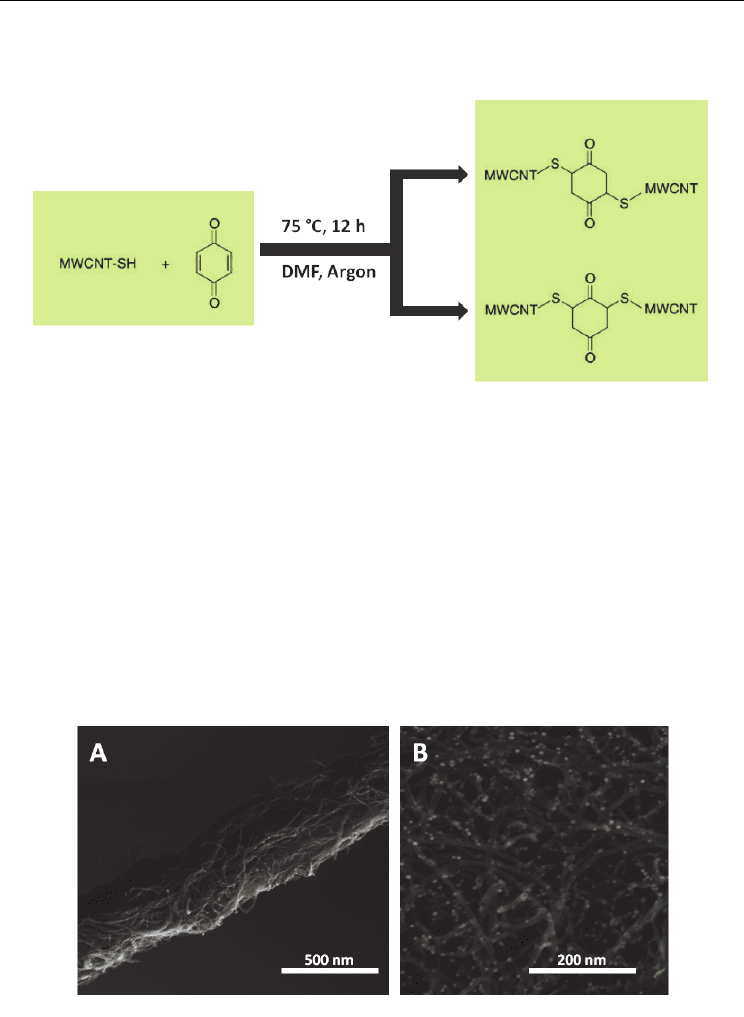
Strategies to Successfully Cross-Link Carbon Nanotubes
671
was noted that the use of a heat gun to maintain the temperature of the mixture at 75 C
aided cross-linking during filtration (Ventura et al., 2010).
Fig. 4. Reaction scheme for cross-linking MWCNT-SH with benzoquinone.
The products formed during the reaction are of two forms, either the 2,5-dithioMWCNT 1,4-
cyclohexanedione adduct or the 2,6-dithioMWCNT 1,4-cyclohexanedione adduct depending
on the steric interactions (Fig. 4.). Several concentration ratios of benzoquinone : MWCNT-
SH were tested to obtain the optimum flexibility of the mat produced. Tensile strength
measurements indicated that the optimum concentration of benzoquinone : MWCNT-SH
was 5:1 and the SEM images inferred the that there was sufficient cross-linking (Fig. 5A)
The 10:1 composite produced a brittle mat confirming the link between the increasing
strength of the mat and the degree of cross-linking.
The surface of the 5:1 nanotube film also contained unreacted thiol groups that were used to
attach nanocrystals to enhance the functionality. As a demonstration of this principle, we
attached 5.7 ± 0.3 nm gold particles to the surface (Fig 5B).
Fig. 5. A) The SEM images of a cross-linked bundle of nanotubes and B) a nanotube mat
decorated with 5.7 ± 0.3 nm gold particles.
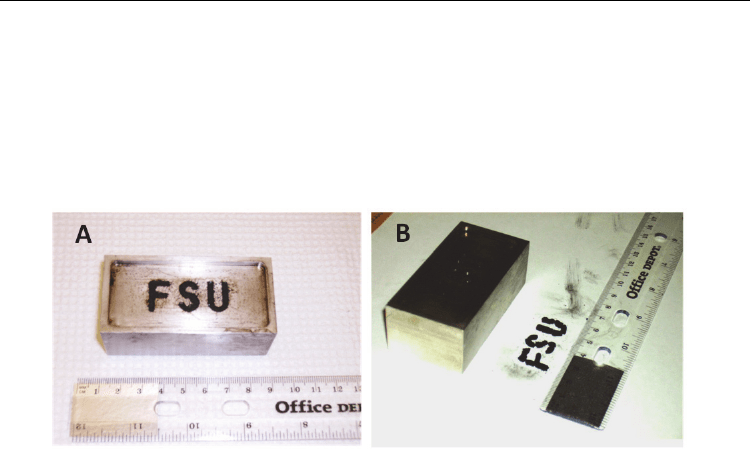
Electronic Properties of Carbon Nanotubes
672
Once the film was produced we wanted to see if we could create a die-cast composite using
a 10:1 ratio of benzoquinone : MWCNT-SH. During this procedure, we injected a predrilled
cast, in the letters “FSU”, with the cross-linking mixture of benzoquinone and MWCNT-SH
and placed the cast on a hotplate heated to 75 C. We periodically injected more of the
mixture as the liquid level dropped until the cast was full, and left the cast at 75 C for 9
hours before cooling to room temperature (Fig. 6A). The cross-linked FSU blocks were
removed with the aid of a scalpel in smaller blocks (Fig. 6B).
Fig. 6. A photograph of A) the letters FSU cast into a stainless steel container with a 10:1
mixture of benzoquinone : MWCNT-SH injected into the cast. B) The cross-linked composite
removed from the cast after heating.
Although the removal of the composite from the cast was difficult, it was primarily due to
the design of the cast. We plan to explore the use of bismaleimide groups to generate similar
composites. We are also exploring alternative methods to modify the carbon nanotubes. One
method that we find intriguing is the use of a mechano-chemical approach. This is a novel
method in the field of CNTs and provides an alternative route to attach functional groups to
the surface of CNTs by ball-milling the tubes in the presence of a reactive gas. The milling
creates defects on the tubes which react with the gas forming covalent attachments (Konya
et al., 2002).
For cross-linking, it is preferential to have a fairly uniform CNT size and distribution of
functional groups on the surface. Both of these requirements were addressed in research
into the mechano-chemical functionalization of CNTs with a ball mill, for the generation of
surface thiols, chlorides, acyl chlorides, amines and amides.
The process involved placing purified CNTs into a ball-mill and degassing in a heated N
2
environment or in a vacuum. The reactant gas was then pumped through the chamber untill
the milling process was complete. The excess reactant is removed by the evacuation of the
chamber, and the tubes are subsequently washed with ethanol. The research noted that
extended periods of milling resulted in the generation of amorphous carbon and lattice
fragments with a 30-35% amorphous content formed after a period of 2 weeks. The milling
process shortened the tubes and this was also carefully controlled by the cumulative milling
time.
The results inferred that the CNTs obtained had a high degree functional groups around the
surface as indicated by IR and XPS, and the process can be scaled up depending on the size
of the mill.
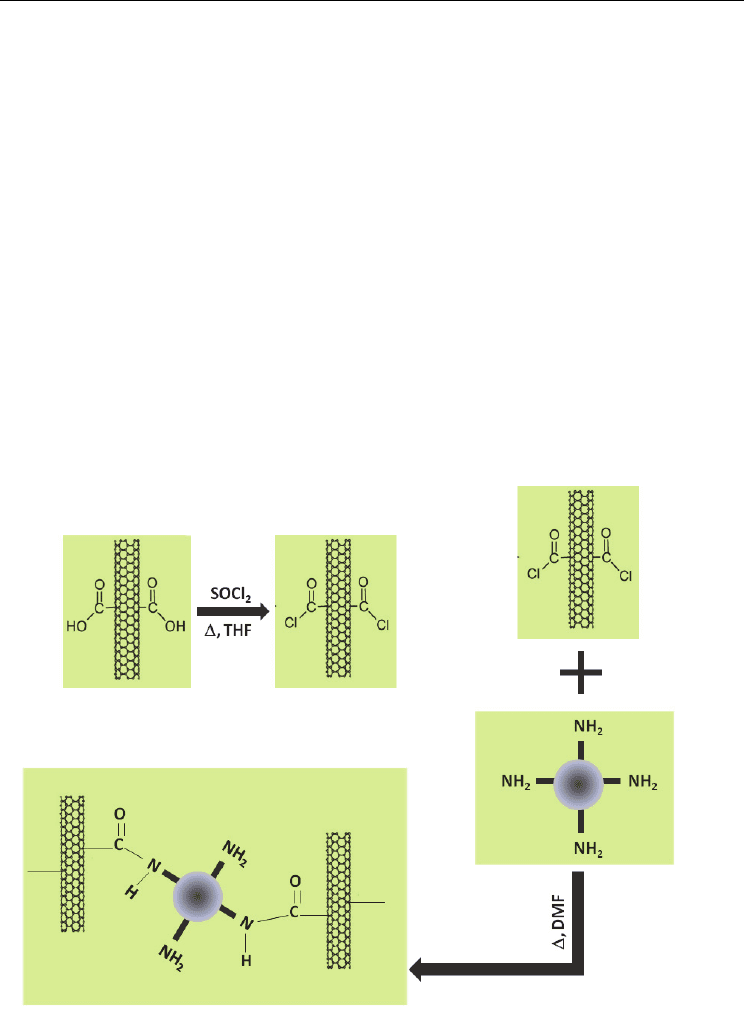
Strategies to Successfully Cross-Link Carbon Nanotubes
673
2.4 MWCNT-Titania films
There are many theoretical ways to improve the photocatalytic efficiency of titania (TiO
2
)
including increasing the surface area of TiO
2
or creating methods to promote charge
separation, but there needs to be a better way of promoting electron transport. Therefore,
the development of new materials that are capable of increasing the efficiency of electron
mobility are required. CNTs are known to be a good candidate for use with TiO
2
because of
the semiconducting and metallic behavior depending on the diameter of the tubes and
helicity. Enhancing the photocatalytic properties of titania is extremely important, especially
when it is considered as a potential for the photocatalytic reduction of CO
2
with H
2
O (Xia et
al., 2007). Titania itself exhibits good photostability properties; however the photocatalytic
reaction with CO
2
is insufficient for applications. This problem was reduced significantly by
the application of carbon nanotubes as a mediator of electron transfer and MWCNTs have
been investigated for their charge transfer properties with titania, but a suitable composite
needs to be constructed.
We have constructed a nanotube film which uses aminated titania particles as a cross-linker
for CNT films (Fig. 7.). In a departure from the standard cross-linking theory, we wanted to
examine the potential for these beads to act as cross-linkers in CNT films. In addition to the
formation of amide bonds, the nature of interaction allows for the potential of electron
transfer from TiO
2
to the carbon nanotubes.
Fig. 7. Reaction scheme of the acylation of CNTs followed by the cross-linking of an
aminated titania bead.
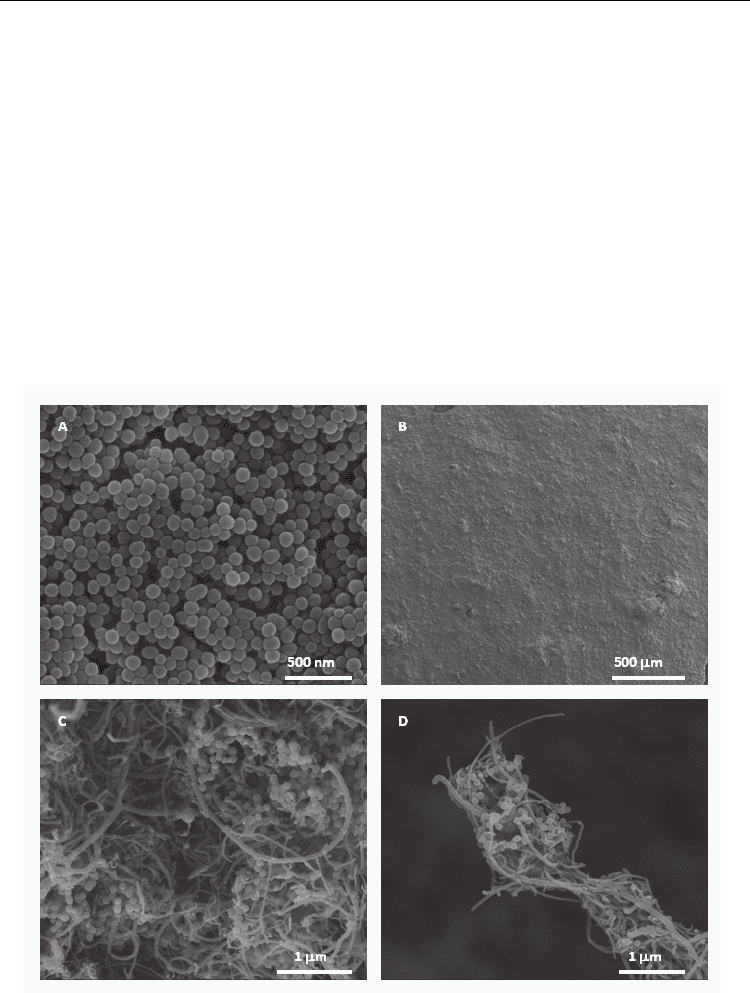
Electronic Properties of Carbon Nanotubes
674
MWCNT-COOH (1 g, 50-80 nm OD, Nanostructured & Amorphous Materials Inc.) were
converted to MWCNT-COCl by heating the nanotubes under reflux for 3 days in THF with
thionyl chloride. The MWCNT-COCl were washed with excess THF under vacuum and the
tubes were dried over a period of 24 h. The MWCNT-COCl (100 mg) were sonicated for 10
minutes whilst TiO
2
-NH
2
(25 mg/ml, Corpuscular Inc.) 100 nm particles (Fig. 8A) were
added. The mixture was further heated under reflux and slowly vacuum filtered whilst hot
to produce a thick film. The films were brittle but the SEM images indicated a sufficient
dispersion throughout the composite. The particles are amorphous but can be easily
converted to anatase or rutile by heating, making the film a good candidate for
photocatalytic activity.
Using particles and nanocrystals as cross-linking agents is of great interest for increasing the
surface area for reactivity. Examples can found in literature of the use of such constructs in
the formation of photoreactive composites of CNTs and titania (Yao et al., 2008) and Pt
nanoclusters/titanium dioxide nanotube composites (Dong et al., 2010). In order to increase
the utility of these composites, they would need to be processed into films to fully take
advantage of their unique properties.
Fig. 8. SEM images of A) aminated titania particles B) low magnification image of the film C)
a high magnification section of the film surface D) A highly cross-linked fiber at the edge of
the film.
